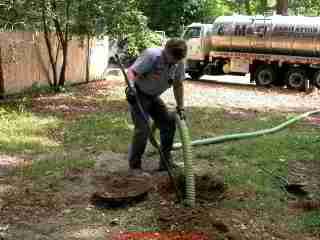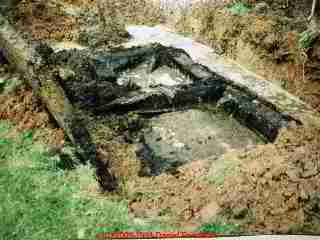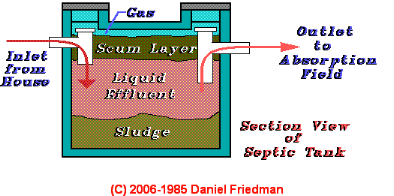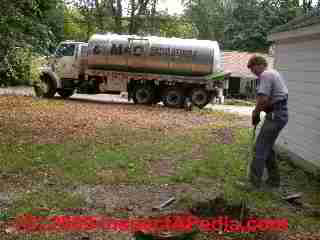 Septic System Maintenance - Why Does a Septic Tank Need Cleaning?
Septic System Maintenance - Why Does a Septic Tank Need Cleaning?
- POST a QUESTION or COMMENT about the requirement to clean or pump out septic tanks & about pumping the septic tank "off schedule"
Why pump the septic tank?
Here we explain why a septic tank needs to be pumped regularly, how septic tanks are cleaned, how much it costs to pump a septic tank, how to inspect and clean septic tanks safely, what is septic tank effluent retention time, how to measure septic tank scum and sludge levels, and other septic tank maintenance advice for homeowners. How often should septic tanks be pumped? Then we discuss reasons to pump out or clean a septic tank "off schedule" such as before a big party or for diagnostic reasons.
InspectAPedia tolerates no conflicts of interest. We have no relationship with advertisers, products, or services discussed at this website.
WHY DOES A TANK NEED PUMPING? A Basic Explanation of What Happens in a Septic Tank
 Why should septic tanks be pumped out?
Why should septic tanks be pumped out?
What causes septic field failures?
Understanding the proper procedures for septic tank care, septic tank cleaning frequency, and other septic tank maintenance chores, will permit the owner of a home with an onsite septic system to maximize the life of the system and to assure that it is working properly.
[Click to enlarge any image]
The most common domestic wastewater treatment system used in rural areas is the septic tank-soil absorption system. The septic tank removes settleable and floatable solids from the waste water. The soil absorption field then filters and treats the clarified septic tank effluent and distributes it through the soil.
Removing the solids from the wastewater protects the soil absorption system from clogging and failure. In addition to removing solids, the septic tank also promotes biological digestion of a portion of the solids and stores the remaining undigested portion.
The first stage of the treatment system, the septic tank, removes solids by holding wastewater in the tank. This allows the heavier solids to settle as sludge and the lighter particles to form scum at the top.
To accomplish this, wastewater should be held in the tank for at least 24 hours. Up to 50 percent of the solids retained in the tank decompose; the remainder accumulate in the tank. Biological and chemical additives are not needed to aid or accelerate decomposition.
 The small, collapsing, and totally impacted septic tank shown above was ignored by the property owner for
years, leading to total failure of the system.
The small, collapsing, and totally impacted septic tank shown above was ignored by the property owner for
years, leading to total failure of the system.
This figure shows a tank in cross-section. You will see that the liquid septic effluent volume has as available space the area between the underside of the floating scum layer at the top of the septic tank and the upper side of the settled sludge layer on the tank bottom.
As a septic system is used, sludge continues to accumulate in the bottom of the septic tank.
Properly designed tanks have
enough space for up to three years safe accumulation of sludge, but the actual time you can allow between septic
tank pumpouts depends on tank size and level of usage.
See TANK PUMPING SCHEDULE for a table relating septic tank size and usage to pumping frequency.
When the sludge level increases beyond the maximum design point, sewage has less time to settle out as scum or sludge before leaving the tank and more suspended sewage solids will flow out of the septic tank into the absorption area or drainfield.
We explain this further at EFFLUENT RETENTION TIME
If too much sludge accumulates in a septic tank, no settling occurs before the sewage flows to the soil absorption field. Infiltration of sludge into the soil absorption field will shorten the drainfield life and thus cause system failure by clogging the absorbing soils around the field. To prevent this, the septic tank must be pumped on the proper schedule. The material pumped out of the septic tank is known as septage, raw sewage, or blackwater.
Other reasons to pump out or clean septic tanks
Unscheduled septic tank pumpout advice: this document explains additional reasons for pumping the septic tank at times other than those provided by septic tank pumping tables.
We describe a list of circumstances that recommend an "extra" or unscheduled cleanout and inspection of the septic tank such as a marginal septic system that is about to be subjected to high usage during a party, or in response to a sewage backup into the building, following area flooding, and as part of diagnosing a failure of the septic system or any of its components.
Readers should see
WHEN to CLEAN THE SEPTIC TANK and in the table shown
at SEPTIC TANK PUMPING FREQUENCY GUIDE we've discussed the basic guidelines and tables used to determine when a septic tank should be pumped. But There are other reasons besides time or sludge/scum layer thickness that lead people to pump septic tanks out.
Here's a list of other reasons to pump the septic tank along with links to more details:
- Before the party: you can reduce the chances of a septic system backup as well as avoiding overloading the drainfield if you have the septic tank pumped right before any anticipated heavy usage such as having many visitors or having a large party with many guests in your home. We discuss this suggestion in detail
at SEPTIC BACKUP PREVENTION. - Septic Pumping in Response to Sewage backups: pumping a septic tank because drains are backing up in the building is a "band aid" that
gives very short relief since the tank will fill again quickly, perhaps in just a day or so of use.
The reason for the septic backup needs to be determined.
If the septic system is backing up because the tank is totally blocked by solid waste the tank needs to be pumped but the owner needs to be warned that the drain field has been damaged and has less remaining life. If the septic system is backing up because the drain field itself is failing and refuses to accept effluent, the drain field needs to be replaced.
See SEWAGE BACKUP DIAGNOSIS & HAZARDS IN BUILDINGS - If the septic system drains are clogged the clog needs to be found and cleared.
See CLOGGED DRAIN DIAGNOSIS & REPAIR - Houses being sold: often an owner or realtor will arrange for a septic tank to be pumped just before a home inspection
or before a septic system inspection or septic loading and dye test.
Such a "favor" performed for the buyer is in fact preventing a valid septic inspection and test since an empty tank means the drain field can't be tested. This is a fraudulent act and should not be tolerated.
See WHEN NOT TO PUMP A SEPTIC TANK - Septic tanks exposed to flood conditions need to be pumped and inspected as the tank may have been
filled with backing up silt or mud.
See SEPTIC SYSTEM FLOOD DAMAGE REPAIR - Filled cesspools are often "repaired" by pumping and perhaps by other means such as agitating the
cesspool bottom or sides. If a cesspool is found filled to within 6-12" of the top of the unit it is at end of
life and needs replacement. Pumping some cesspools risks dangerous cave-ins or collapse.
See CESSPOOL SAFETY WARNINGS - Evidence of Septic Failure such as effluent on the property surface in the drain field area or odors leads some people to pump the septic tank. As cited in our first example above, "Sewage backups", this is a futile effort and other diagnosis and repair are needed. See
- Sewage odors sometimes lead people to pump septic tanks. Pumping is not likely to correct a sewer gas
problem though tank inspection may provide some information about system condition.
See DIAGNOSING & CURING SEWER GAS SMELLS AND SEPTIC TANK ODORS
Question: Will septic pumping remove dirt that fell into the septic tank? When?
(Aug 4, 2015) Dave said:
I opened lid to septic tank.
I did not remove all the dirt around the lid. Some dirt fell into the water. Will this dirt sink to bottom and add to the sludge. I live alone and had septic pumped 7 years ago. I maintain it well. I have an effluent filter in the next tank. Does pumping remove mud and sludge from the bottom? When should I have it pumped?
Reply:
Dave: proper septic tank pumping includes removing the settled sludge (and any dirt that fell in) from the bottom of the septic tank. If your pumper leaves more than a trivial amount of sludge on the tank bottom he's not doing a great job.
See SEPTIC TANK PUMPING SCHEDULE
or see SEPTIC TANK LEVELS of SEWAGE
or if you prefer, MEASURE SEPTIC TANK SCUM & SLUDGE, for the approaches to determining when to pump the septic tank.
...
Continue reading at SEPTIC TANK PUMPING SCHEDULE or select a topic from the closely-related articles below, or see the complete ARTICLE INDEX.
Or see these
Septic Tank Cleaning Articles
- CLEANING SEPTIC TANKS
- EFFLUENT RETENTION TIME
- MEASURE SEPTIC TANK SCUM & SLUDGE
- SEPTIC SYSTEM INSPECTION LEVELS
- SEPTIC TANK INSPECTION PROCEDURE
- SEPTIC PUMPING CONCLUSIONS
- SEPTIC TANK PUMPING PROCEDURE - home
- SEPTIC TANK PUMPING REASONS
- SEPTIC TANK PUMPING SCHEDULE
- SEPTIC TANK LEVELS of SEWAGE
- WHEN NOT TO PUMP A SEPTIC TANK
Suggested citation for this web page
SEPTIC TANK PUMPING REASONS at InspectApedia.com - online encyclopedia of building & environmental inspection, testing, diagnosis, repair, & problem prevention advice.
Or see this
INDEX to RELATED ARTICLES: ARTICLE INDEX to SEPTIC SYSTEMS
Or use the SEARCH BOX found below to Ask a Question or Search InspectApedia
Ask a Question or Search InspectApedia
Try the search box just below, or if you prefer, post a question or comment in the Comments box below and we will respond promptly.
Search the InspectApedia website
Note: appearance of your Comment below may be delayed: if your comment contains an image, photograph, web link, or text that looks to the software as if it might be a web link, your posting will appear after it has been approved by a moderator. Apologies for the delay.
Only one image can be added per comment but you can post as many comments, and therefore images, as you like.
You will not receive a notification when a response to your question has been posted.
Please bookmark this page to make it easy for you to check back for our response.
Our Comment Box is provided by Countable Web Productions countable.ca
Citations & References
In addition to any citations in the article above, a full list is available on request.
- Our recommended books about building & mechanical systems design, inspection, problem diagnosis, and repair, and about indoor environment and IAQ testing, diagnosis, and cleanup are at the InspectAPedia Bookstore. Also see our Book Reviews - InspectAPedia.
- Wells and Septic System, Alth, Max and Charlet, Rev. by S. Blackwell Duncan, $ 18.95; Tab Books 1992. We have found this text very useful for conventional well and septic systems design and maintenance --DF. Quoting an Amazon description:Here's all the information you need to build a well or septic system yourself - and save a lot of time, money, and frustration. S. Blackwell Duncan has thoroughly revised and updated this second edition of Wells and Septic Systems to conform to current codes and requirements. He also has expanded this national bestseller to include new material on well and septic installation, water storage and distribution, water treatment, ecological considerations, and septic systems for problem building sites.
- In addition to citations & references found in this article, see the research citations given at the end of the related articles found at our suggested
CONTINUE READING or RECOMMENDED ARTICLES.
- Carson, Dunlop & Associates Ltd., 120 Carlton Street Suite 407, Toronto ON M5A 4K2. Tel: (416) 964-9415 1-800-268-7070 Email: info@carsondunlop.com. Alan Carson is a past president of ASHI, the American Society of Home Inspectors.
Thanks to Alan Carson and Bob Dunlop, for permission for InspectAPedia to use text excerpts from The HOME REFERENCE BOOK - the Encyclopedia of Homes and to use illustrations from The ILLUSTRATED HOME .
Carson Dunlop Associates provides extensive home inspection education and report writing material. In gratitude we provide links to tsome Carson Dunlop Associates products and services.


